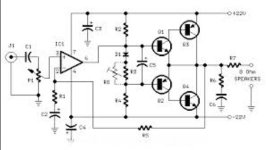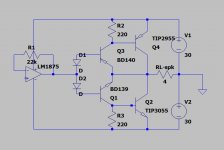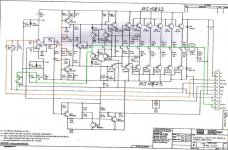tomchr has such designs also using chip amps and incredibly low distortion. PCBs are available too.
Here is something different.
I was in the same boat some months ago. I did something really cool but discovered I actually just got lucky that the circuit worked. This little arrangement I saw recently and while I have not actually tried it, I did try an LM1875 paired to a sziklai pair (quad) output. While I did see the very evident sine output on my scope it looked like there were some spikes assailing the output stage, (image on screen was bouncing around). I am planning to match my output devices and try the circuit again. I used only 220 ohm resistors on the drivers from both rails and 2 diodes on the base of the sziklai input base with output from opamp connected center of those 2 diodes.
The second circuit is to express the idea I tested with sketchy results but may be refined for a very simple poweramp? Will be testing more soon so I guess we will see. Is this something along the lines of what you were asking about or is this 500W PA amplifier with Limiter more suited?
I was in the same boat some months ago. I did something really cool but discovered I actually just got lucky that the circuit worked. This little arrangement I saw recently and while I have not actually tried it, I did try an LM1875 paired to a sziklai pair (quad) output. While I did see the very evident sine output on my scope it looked like there were some spikes assailing the output stage, (image on screen was bouncing around). I am planning to match my output devices and try the circuit again. I used only 220 ohm resistors on the drivers from both rails and 2 diodes on the base of the sziklai input base with output from opamp connected center of those 2 diodes.
The second circuit is to express the idea I tested with sketchy results but may be refined for a very simple poweramp? Will be testing more soon so I guess we will see. Is this something along the lines of what you were asking about or is this 500W PA amplifier with Limiter more suited?
Attachments
Take those as very rough ideas, output stages without emitter resistors will be thermally unstable, and the second circuit has no bias current for the drivers, and the drivers are the wrong polarity!
I temember a Wellelmann amplifier done using only op amp in the dirver stage
Hexfet were used for the final stage.
Hexfet were used for the final stage.
I like it when they use the first op amp as a differential receiver, for twisted pair lines using stereo phone plugs. That cuts hum over 12' of rca cable I use with the ST120 djoffe.
Peavey CS800x & CS800s go from diff input op amp to a 4560 op amp as VAS to voltage gain predriver then double Emitter follower. There's an 800x on louisville craigslist today for $100. I'm listening to an S now that I repaired.
I'm down on LM1875. I built 2 and they motorboated irrepairably on point to point boards. Yeah, I can buy the dual supply speaker burner boards on ebay for $2. NOBODY had the capacitor coupled layout. All the 24 to 36 v transformers I have don't have a center tap, either
Building an Old Fashioned Max from Elvee now, P to P. That won't burn my $600 (new) speakers. Don't need a center tap.
The cs800s & cs800x have DC detection built in, and speaker disconnect relays. Enzo said they really work; haven't need my relays yet.
Peavey CS800x & CS800s go from diff input op amp to a 4560 op amp as VAS to voltage gain predriver then double Emitter follower. There's an 800x on louisville craigslist today for $100. I'm listening to an S now that I repaired.
I'm down on LM1875. I built 2 and they motorboated irrepairably on point to point boards. Yeah, I can buy the dual supply speaker burner boards on ebay for $2. NOBODY had the capacitor coupled layout. All the 24 to 36 v transformers I have don't have a center tap, either
Building an Old Fashioned Max from Elvee now, P to P. That won't burn my $600 (new) speakers. Don't need a center tap.
The cs800s & cs800x have DC detection built in, and speaker disconnect relays. Enzo said they really work; haven't need my relays yet.
Last edited:
Lm318 front end. Bet that hisses as bad as the 741 in CS800 rev A & B.look BGW 750B schematic, LM318 Front End, will work very stable
From your Listening Throne
Actually, probably not all that bad, for a POWER amp. Unacceptable for a preamp or worse for either a microphone input or worst, a magnetic phono cartridge RIAA network.
But look at page 7 - http://www.ti.com/lit/ds/symlink/lm318-n.pdf
And do the math:
I wouldn't call that an audible hiss. There's WAY more random room noise in even the better listening areas that I've been treated to.
However, the noise floor IS a floor: it remains a near-constant regardless of input signal. Let's say our LM318 stage is delivering 20× gain, and the following complementary power output stage, another 2× gain. 40× overall, raising a nominal 1 VRMS to 40 VRMS. Which into 8 Ω is
But its still not something you'd be perceiving from your sweet-spot listening throne.
Just Saying,
-= GoatGuy ✓ =-
Lm318 front end. Bet that hisses as bad as the 741 in CS800 rev A & B.
Actually, probably not all that bad, for a POWER amp. Unacceptable for a preamp or worse for either a microphone input or worst, a magnetic phono cartridge RIAA network.
But look at page 7 - http://www.ti.com/lit/ds/symlink/lm318-n.pdf
And do the math:
√( 20,000 Hz ÷ 20 Hz ) = 31 or so,
31 × 16 nV … = 500 nV audio-band input noise.
If the 318 signal input is at 1.0 VRMS, then the noise floor is about –120 dB from signal. 31 × 16 nV … = 500 nV audio-band input noise.
I wouldn't call that an audible hiss. There's WAY more random room noise in even the better listening areas that I've been treated to.
However, the noise floor IS a floor: it remains a near-constant regardless of input signal. Let's say our LM318 stage is delivering 20× gain, and the following complementary power output stage, another 2× gain. 40× overall, raising a nominal 1 VRMS to 40 VRMS. Which into 8 Ω is
P = ERMS² / R
P = 40² ÷ 8
P = 200 W
So a rather NICE power amplifier! OK…P = 40² ÷ 8
P = 200 W
VN-OUT = VN-IN • gain
VN-OUT = 500 nV × 40
VN-OUT = 20,000 nV
VN-OUT = 20 µV
VN-OUT = 0.020 mV
VN-OUT = 0.000020 V
and ifVN-OUT = 500 nV × 40
VN-OUT = 20,000 nV
VN-OUT = 20 µV
VN-OUT = 0.020 mV
VN-OUT = 0.000020 V
P = ERMS² / R
P = 0.000020² ÷ 8
P = 5×10⁻¹¹ W
and that relative to 1 watt (for speaker conversion)P = 0.000020² ÷ 8
P = 5×10⁻¹¹ W
dB = 10 log10( P / PREF )
dB = 10 log10( 5×10⁻¹¹ ÷ 1.0 );
dB = –103
… now if we bump in a set of really efficient 110 dB/W speakers, dB = 10 log10( 5×10⁻¹¹ ÷ 1.0 );
dB = –103
SPL = dBW speaker sensitivity + dBW power to them
SPL = 110 + (–103)
SPL = 7 dB (audio);
Which is at 1 meter. You could 'improve' upon that by getting your ear really, realy close to the tweeter (within a couple of inches), and get to 40 dB or so. SPL = 110 + (–103)
SPL = 7 dB (audio);
But its still not something you'd be perceiving from your sweet-spot listening throne.
Just Saying,
-= GoatGuy ✓ =-
Thanks for the analysis. Never know how to compare microvolt noise figures to sqrthz noise figures.Actually, probably not all that bad, for a POWER amp.
-= GoatGuy ✓ =-
A 4558 is 1.4 microv typical, which is triple 500 nv.
4560 in CS800s that I'm listening to right now TI says is typical 1.2 microv @ 2000 ohm source impedance, which is about what I'm feeding with. ST33078 as line drivers in a modified RA-88a mixer. Nice & quiet at 1 W output into 102 db 1w1m speakers, except for a little hum on left channel. Peavey used JRC4560 instead of TI, there might be a reason besides cost.
Bought a used PV8 mixer Monday which will drive 4 m twisted pair TRS cables to the CS800s, instead of the 4 m RCA plug cables I'm using now. That might reduce the hum. PV8 uses rohm 4562 op amps.
Last edited:
Hi Freecrowder,
Quite a coincidence. I recently ordered some PCB's for such an amp.It is a very
simple configuration with an NE5532 in the front, each half driving one channel,
and the current is supplied to the speaker by means of a CFP pair biased by 2
diodes fed by 2*2 resistors providing bootstrapped drivers for the CFP's. I hope
to receive the boards before the end of January.The amp will run from a
2*12V transformer and will provide around 8 Watts of power per channel.
The board houses 2 channels plus the power supply. If you are interested,
please send me your postal address to selim_ardali at yahoo.com.
Happy 2020 everybody
Selim
Quite a coincidence. I recently ordered some PCB's for such an amp.It is a very
simple configuration with an NE5532 in the front, each half driving one channel,
and the current is supplied to the speaker by means of a CFP pair biased by 2
diodes fed by 2*2 resistors providing bootstrapped drivers for the CFP's. I hope
to receive the boards before the end of January.The amp will run from a
2*12V transformer and will provide around 8 Watts of power per channel.
The board houses 2 channels plus the power supply. If you are interested,
please send me your postal address to selim_ardali at yahoo.com.
Happy 2020 everybody
Selim
Only one problem, you got the maths wrong.And do the math:√( 20,000 Hz ÷ 20 Hz ) = 31 or so,If the 318 signal input is at 1.0 VRMS, then the noise floor is about –120 dB from signal.
31 × 16 nV … = 500 nV audio-band input noise.
BW = 20000 - 20 = 19980, √19980 ~= 141
16nV x 141 = 2.25µV rms
[ you divided frequencies by mistake ]
So 113dB down from 1V rms, ignoring source resistance / current noise.
The only one that I found was any good was the Mark Alexander amplifier. If you want something simple, look up the PW Texan - but dont expect good performance
Only one problem, you got the maths wrong.
BW = 20000 - 20 = 19980,
√19980 ≈ 141
16nV x 141 = 2.25µV rms
[ you divided frequencies by mistake ]
So 113dB down from 1V rms, ignoring source resistance / current noise.
Johnson–Nyquist noise - Wikipedia
So … you are right. You know what happens to milk if you leave it sit about for some time? It sours. Memories are similar, but with (usually) a longer decay time. Mine is some gazillion years old.
I think the reason I got it in my head that it was a BW = HI/LO kind of thing was because of the radical part. No matter. Wrong is wrong, no matter how cheesy the milk smells.
And yes, being off by essentially a factor of 20 log10( √(20) ) = +13.0 definitely skews things. But not TOO much! I think that “is good enough for a conventional monoblock power amplifier” is still likely the right opinion.
Just Saying,
-= GoatGuy ✓ =-
PS - ⊕5 if I could … 'cuz you used the right symbols. √ … ≈ … µV
Last edited:
look BGW 750B schematic, LM318 Front End, will work very stable
Almost any bgw for that matter, popular model 250 runs on 55+/-, sounds better than it should.
- Home
- Amplifiers
- Solid State
- Power amp w/ Opamp front end.


